RV camping can be an expensive pursuit. Check out the price tag on a brand new Airstream if you need proof.
After years of camping in old, used trailers found on Kijiji, last spring we took the plunge and purchased a 2019 Geo Pro right off the lot. We then doubled down and added a 2018 Nissan Pathfinder right off the lot to tow it. It was a splurge. It was well out of our comfort zone. And until we went camping at Bighorn Campground by Ya Ha Tinda Ranch, I figured it was the most expensive thing we would ever do for camping. I was nearly wrong.
Ya Ha Tinda, which means “mountain prairie” in Stoney, is a little piece of heaven hidden away on the eastern slopes of the Rocky Mountains just outside the boundary to Banff National Park. Located 150 km northwest of Calgary and 85 km east of Sundre, it’s not what you’d call “easily accessible”.
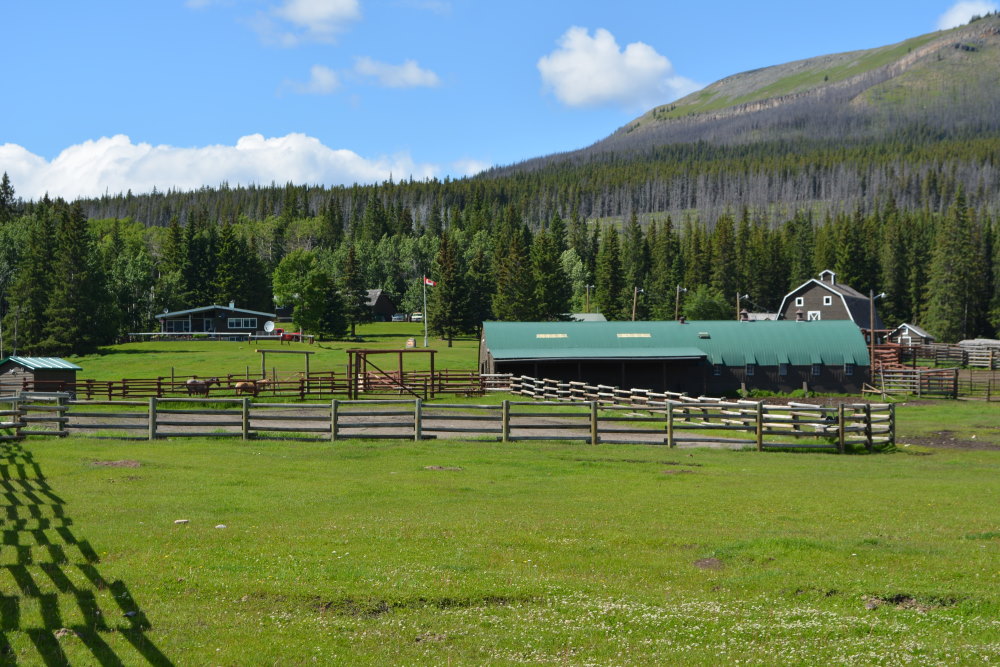
We had never been out that way but were peripherally aware that it was isolated. As such, we were concerned about gasoline; specifically, running out of it. The last thing I wanted with our fancy new trailer and fancy new SUV was to get stranded in the western Alberta wilderness with no means to fill up our tank. Yeah, I’ve been city living too long.
To minimize our (in retrospect, baseless) fears, I planned to drive to Sundre, fill up with gas, then head west rather than take the more direct route from Calgary via Cochrane which, though shorter overall, required a longer drive after the last known gas station was passed.
The result of using this more circuitous (have I mentioned unnecessary?) route was that we drove the final third of the distance to Ya Ha Tinda on gravel roads straight out of a M.A.S.H. episode. I’m still stunned with didn’t destroy both our vehicle and trailer.
One particular pothole, a hidden son-of-a-bitch on the far side of a short bridge, jolted every atom in our rig, not to mention our bodies. I’m convinced we momentarily phase-shifted into a parallel universe. It remains unclear if subsequent potholes repeated the phase-shift cycle or actually knocked us back to this universe. Whatever the case, it’s a goddamned miracle neither the trailer nor the vehicle sustained any damage.
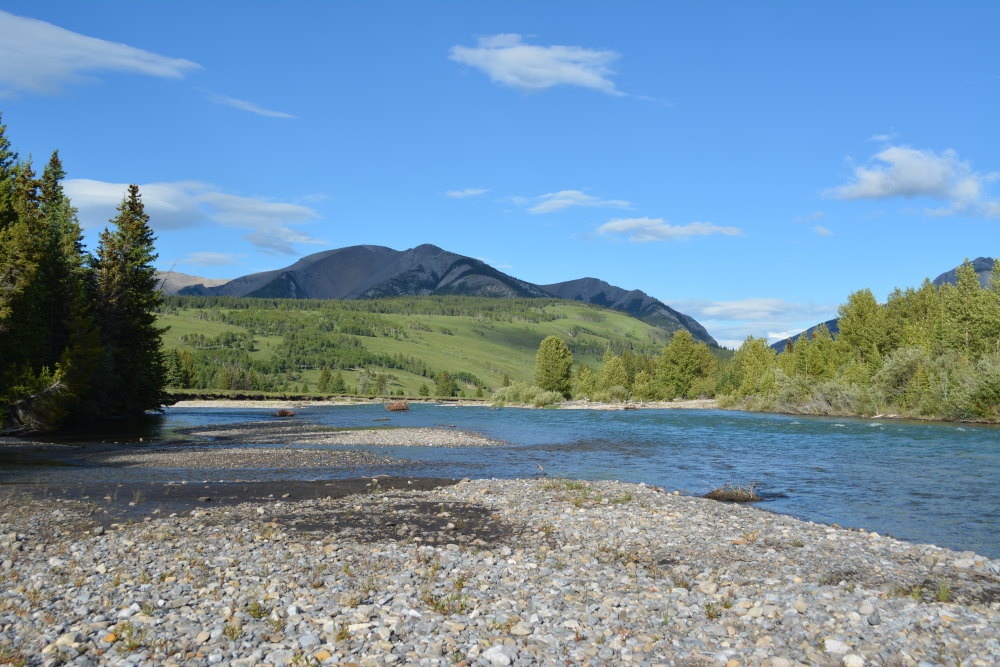
Having learned a spinal compressing lesson on the way to Ya Ha Tinda, and fully realizing it was unwarranted as far as gas concerns go, we returned to our city home using the shorter, original route Google had suggested.
This route, which heads southeast towards Cochrane, was no less gravelly, but the condition of this gravel road was night and day compared to the abomination west of Sundre. This time our biggest concern was dust.
An overly wide, groomed, grey gravel surface, the forestry trunk road was a veritable dream by comparison. In fact, when we finally did hit blacktop, the road quality actually diminished in terms of width and smoothness. The only negative was the fact that dust overwhelmed the roadway whenever multiple vehicles caught up to each other. That wasn’t a pleasant experience, but at least it wasn’t a danger to undercarriages.
I suspect the drive to and from Ya Ha Tinda Ranch is, in no small part, the reason it remains a lesser-known, lesser-used oasis. Despite the near catastrophic implications of those cavernous potholes, they were a blessing in disguise. Ya Ha Tinda is an exquisite place unsullied by the masses of weekend warriors that congest campgrounds and parks around the province.
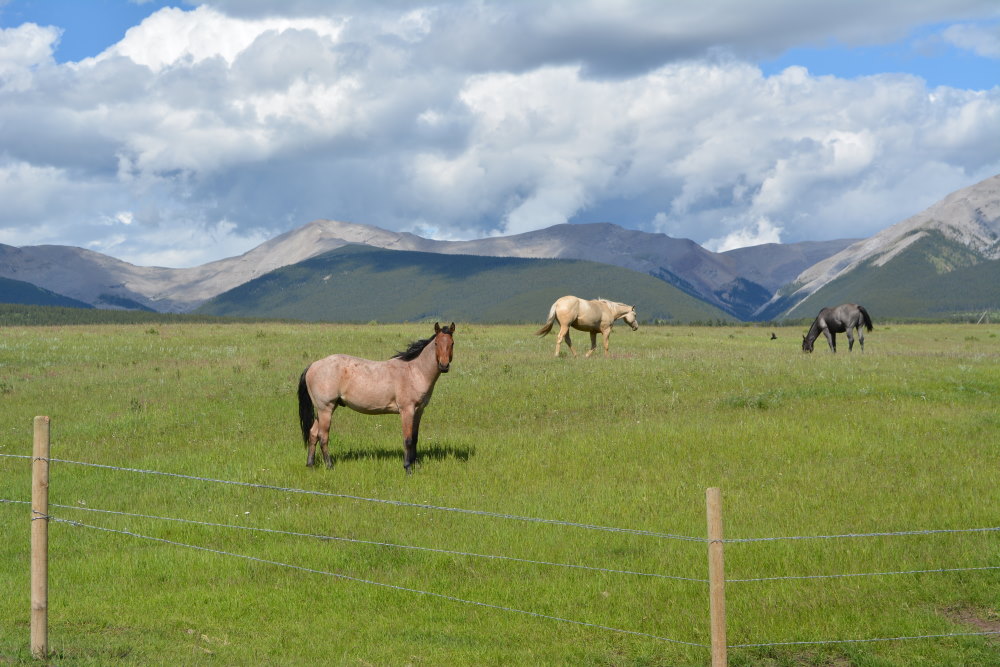
Located on the eastern boundary of Banff National Park, Ya Ha Tinda Ranch itself is a working ranch operated by Parks Canada. For nearly a century, the ranch has been used for raising and training work horses for rangers in the various mountain national parks.
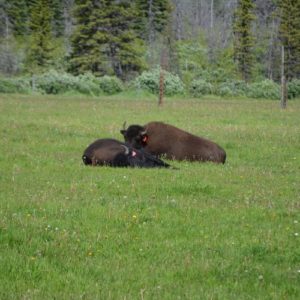 The modern world of ATVs and quads has diminished the need for such horses, so the ranch isn’t as busy as it was during its heyday (hay day? HA!), but it’s still active. We saw a few horses in the fenced pastures west of the campground. These animals are gorgeous set against the rocky mountains of the eastern slopes. We also unexpectedly saw three bison there too. Perhaps they are sick or were part of the recent bison relocation program from Elk Island National Park into Banff?
The modern world of ATVs and quads has diminished the need for such horses, so the ranch isn’t as busy as it was during its heyday (hay day? HA!), but it’s still active. We saw a few horses in the fenced pastures west of the campground. These animals are gorgeous set against the rocky mountains of the eastern slopes. We also unexpectedly saw three bison there too. Perhaps they are sick or were part of the recent bison relocation program from Elk Island National Park into Banff?
With the ranch’s existence solely due to horses, it’s fitting that this stunning piece of prairie hidden in the mountains has become an equestrian wonderland for horse owners. Unlike other recreational and tourist areas in the province, Ya Ha Tinda is for horse people. Others are not banned from the place, mind you, but horses dominate. Hikers no doubt find solace here as well, and hunters seek their prey in the crown lands surrounding the place, but Bighorn Campground and Ya Ha Tinda is first and foremost for horse people.
We, to the contrary, are not horse people. I personally don’t understand the fascination so much of society has for these enslaved creatures. But my kids like them and fortunately I have an aunt and uncle living nearby whom own several horses. My aunt takes my kids riding around her hobby farm every time we visit, so a horse camping trip to Ya Ha Tinda was a natural progression.

What awaited us at Ya Ha Tinda was unlike any camping experience I’ve ever had. Far more akin to backcountry camping than the coddled, front-country, resort camping we typically do, Bighorn Campground is a campground in the same sense that I am an athlete.
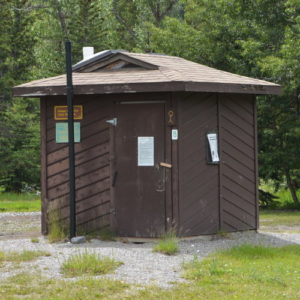 Pit toilet shacks and concrete-based, metal horse stables are the only artificial structures to be found at Bighorn Campground. Otherwise, it’s nothing more than a rocky, riverside mountain meadow at the edge of a forest. It don’t get more rustic than that, y’all.
Pit toilet shacks and concrete-based, metal horse stables are the only artificial structures to be found at Bighorn Campground. Otherwise, it’s nothing more than a rocky, riverside mountain meadow at the edge of a forest. It don’t get more rustic than that, y’all.
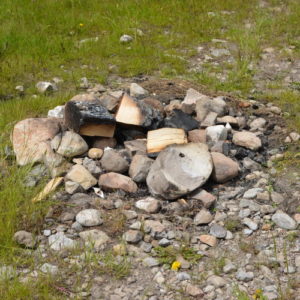 A volunteer operated campground within the greater Ya Ha Tinda ranch lands, Bighorn is actually a refreshingly unstructured experience. There are no site numbers. There are no reservations. There really aren’t even campsites, for that matter. Rather, there are generally agreed upon open spaces which constitute a “site”. Most are recognizable solely by the fieldstone fire rings dotting the grounds with the horse stables and high-ties offering additional delineations.
A volunteer operated campground within the greater Ya Ha Tinda ranch lands, Bighorn is actually a refreshingly unstructured experience. There are no site numbers. There are no reservations. There really aren’t even campsites, for that matter. Rather, there are generally agreed upon open spaces which constitute a “site”. Most are recognizable solely by the fieldstone fire rings dotting the grounds with the horse stables and high-ties offering additional delineations.
Some “sites” are sheltered, with trees all around. Others are wide-open, rocky meadow. People just set up their tents and RVs wherever things seem relatively level, a near impossible endeavour on account of the rocks and gopher holes that punctuate the landscape.
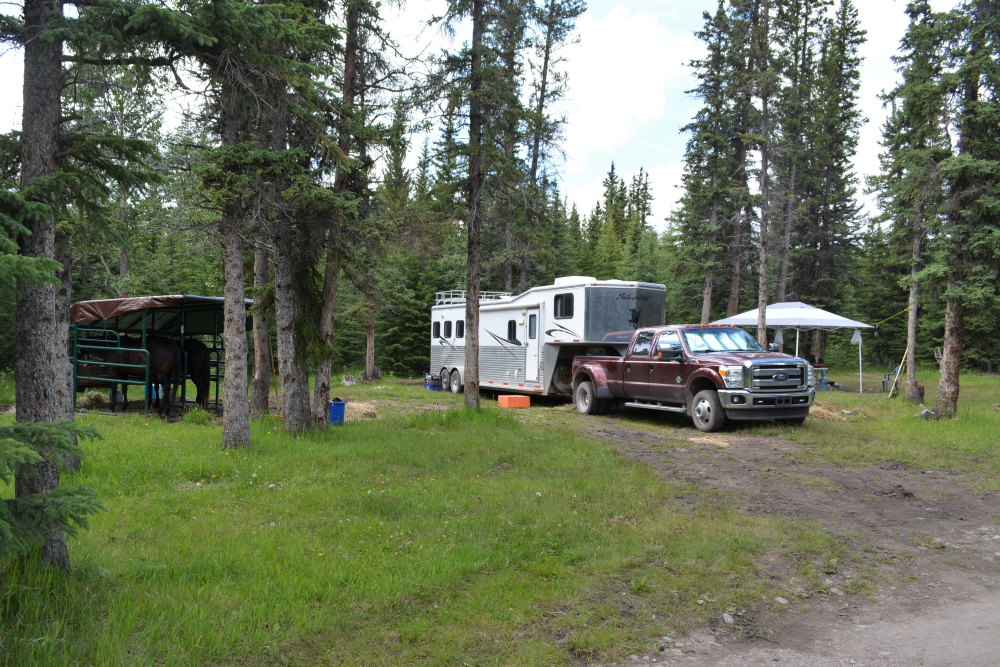
With horseback riding being such a social pursuit, many neighbouring “sites” are amalgamated into one by groups of friends or family who arrange their tents and trailers around a central firepit and picnic table as if “circling the wagons” like prairie settlers in days of yore. It’s kind of cool, to be honest.
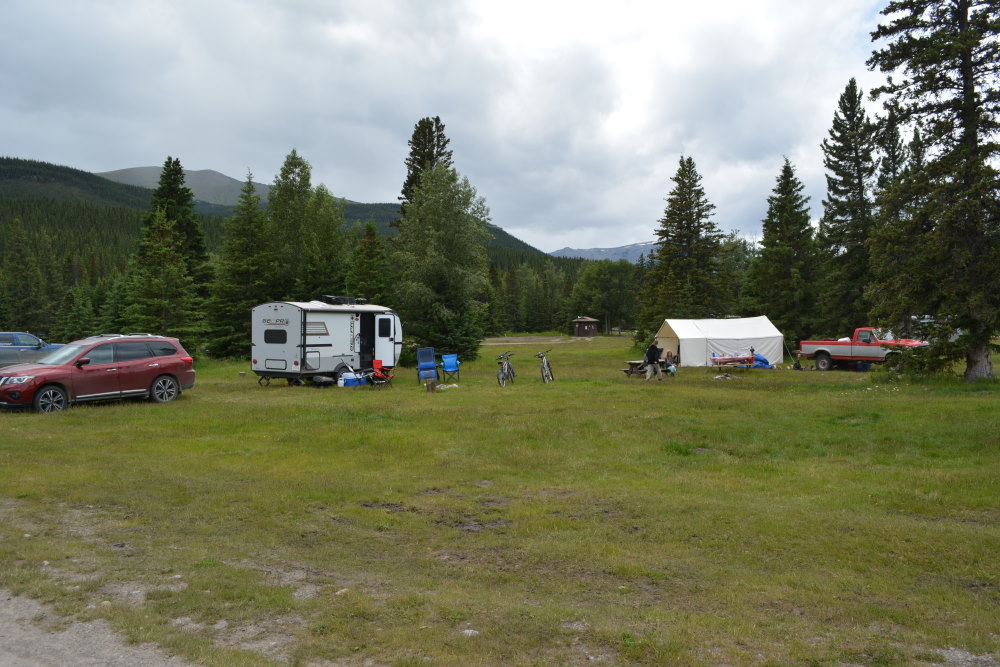
As you can imagine, there are no services here. No power. No sewer. No water. You either bring water with you or you scoop it up from the Red Deer River that flows beside Bighorn Campground and boil it. It’s cool, clear, mountain water and colder than a witch’s tit. It’s a shame you have to boil it.

Neither is there any firewood for sale. You’ll have to bring that with you too if you want to cook over a fire or simply enjoy an evening beside the flames. Sorry, chainsaws won’t cut it. Ha! See what I did there?
Likewise, you are off the grid there. Like, waaaaaay off the grid. Telegraph would be mind-blowing technology. You won’t get cell service out there nor will you be checking up on your Facebook wall using free campground WiFi (there isn’t any). You come to Ya Ha Tinda to escape. All of it.
That too likely keeps a good number of campers away from these parts, but despite my withdrawal symptoms, it was a therapeutic diversion from modern life. Besides, we were only there for two days, unlike my aunt and uncle who stayed the full week, so my torment was tolerably short-lived.

Bighorn Campground is operated by Friends of the Eastern Slopes and is entirely funded through donations and fundraising events. You don’t pay for your “site” though you can leave a donation with the caretaker, a grizzled, older gentleman who looks right out of a Steinbeck novel and spends his summers at the campground looking after everything and everyone.
With no site numbers, I can’t really say how many “sites” there are or whether Bighorn Campground ever gets full. I don’t even know if that’s possible with such a flexible setup. That said, our visit occurred midweek and I’m sure the remaining open spaces fill up quickly once the weekend rolls around.
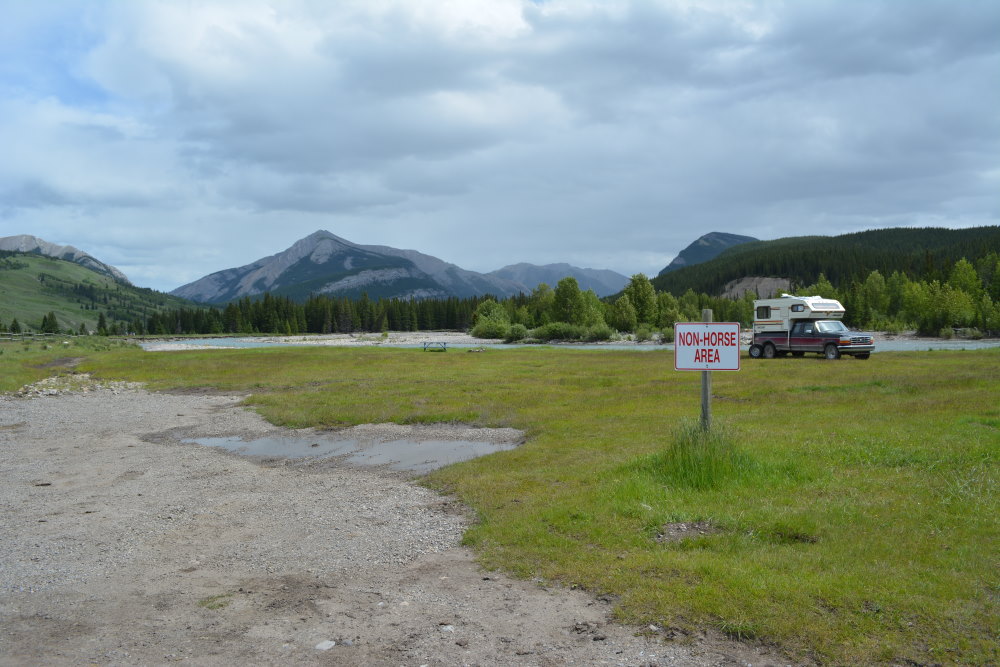
And though the place is openly catering to campers with horses, there is a separate area for non-horse campers. It’s a small grass field beside the river. There was one truck-mounted camper there during our stay. If you enjoy rustic camping in your tent or RV, I wouldn’t shy away from Ya Ha Tinda just because you don’t have a horse. You’ll be an anomaly, sure, but a happy one.
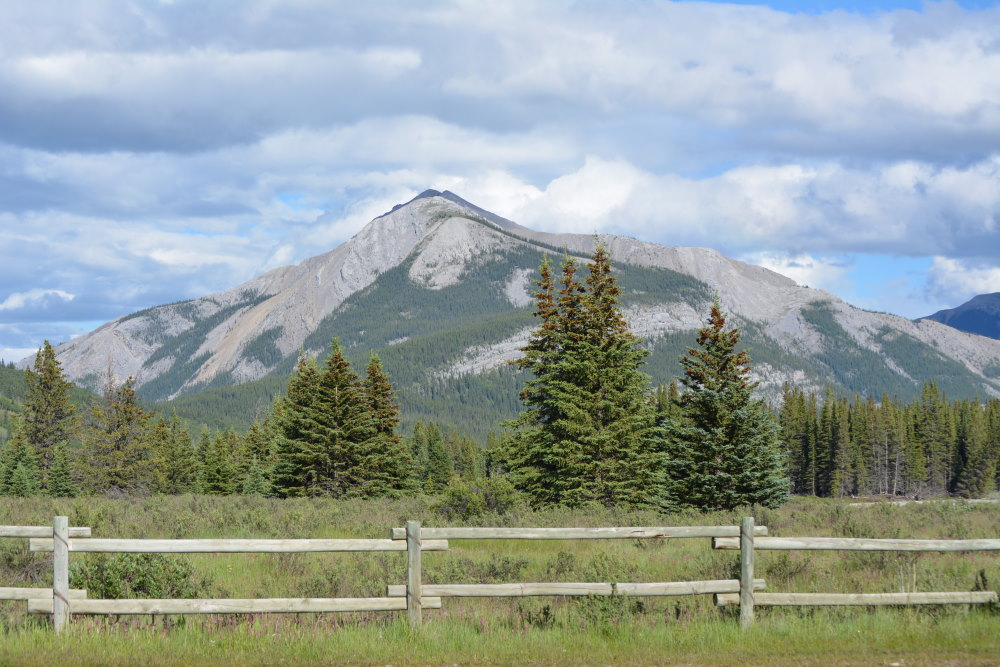
Because what Bighorn Campground lacks in amenities, it makes up for in scenery. It is heavenly out there. I kid you not. Rocky Mountains, less snow-covered and more weathered to the east than to the west, surround the ranch. The Red Deer River headwaters flow through its gravelly bar-strewn channel along the south boundary of the campground, while the Bighorn River, a smaller tributary, makes the western campground boundary.

Trails abound in the area taking you deep into the woods or up onto mountain tops or out into open meadows. Following a trail along the Bighorn River from the campground/ranch entrance takes you to Bighorn Falls, a lovely waterfall spilling into a canyon cut into a rocky, wildflower-filled meadow.
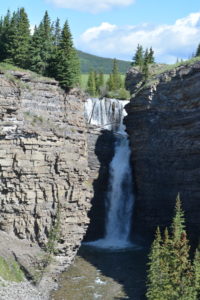
Obviously this is what draws the riders to Ya Ha Tinda. I don’t ride so besides the trail to the waterfall I didn’t explore too much on such a short trip. My kids went a little further afield during their horse rides with my aunt typically, following the Red Deer River through beautiful, mountainside grasslands hunting fossil-bearing river rocks.
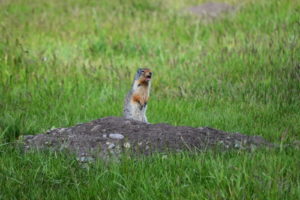
That’s not to say that being stuck in Bighorn Campground is unpleasant. You could sit for hours basking in the beauty literally surrounding you. With nice weather, a comfy lawn chair, a tasty beverage, and a bag of cookies, there’s no better way to reconnect with your inner Neanderthal.
Wildlife abounds here as well. Herds of elk are regularly seen grazing in the meadows. You will certainly see more than a few squealing gophers popping up from their burrows for a view of the bipedal invaders. The ravens are a tad noisy but if you see the Osprey you’ll forget and forgive their ornithological rudeness.
This is bear country (and cougar country … and maybe even wolf country), of course, so smart camping is a must, though the activity and horses around the campground likely keep these bulky predators away to some degree. Out on the trails, caution is warranted.

Aquatic wildlife is another animal pursuit you might enjoy. We tried fishing with lures, but the water was flowing far too quickly. Fly fishing is surely a more appropriate method but I don’t have such equipment or skills. Whatever, the kids enjoyed casting their lines for a while and in these surroundings, do you really care if you catch anything?
When all the daytime activities are complete, Ya Ha Tinda delivers one final, stunning treat. Isolation from civilization offers many benefits to our encumbered souls but none rival a genuine night sky. This was by far the highlight for me. It was early July so you had to wait for it at these latitudes, but the night sky was glorious.
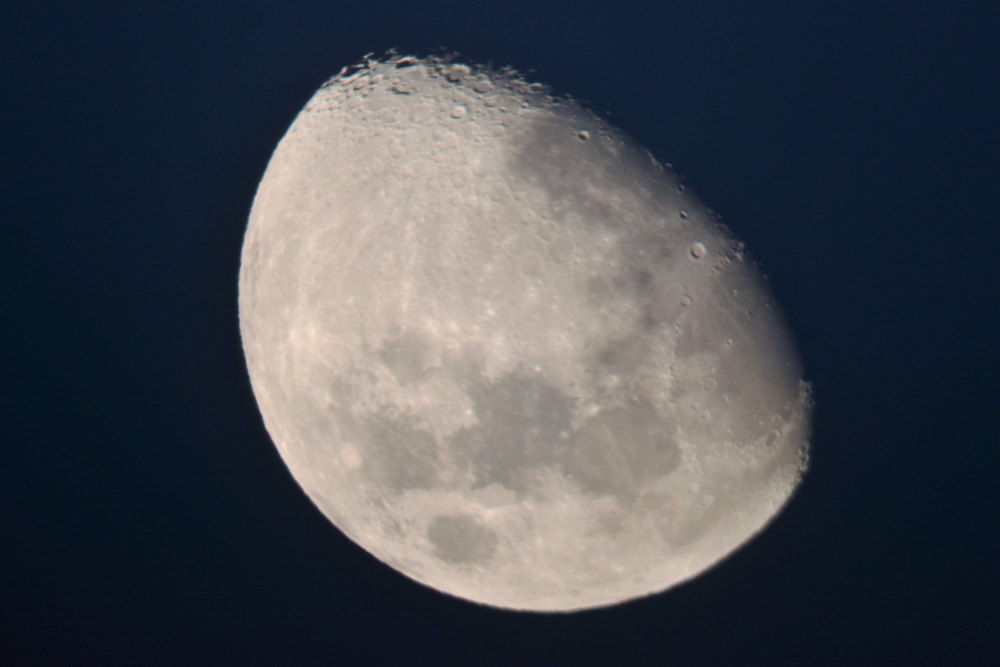
Expecting such a special experience, I brought along my telescope for some amateur planet gazing. The half-moon was amazing to see through the scope with craters vividly observable, particularly along the boundary between light and dark. We also bore witness to Jupiter and its four major moons as well as Saturn and its rings. Seeing these celestial bodies “in person” never gets old.
Of course, just sitting around a campfire in the wilderness like this is enjoyable too. Add in some friends and family and the experience is soul-strengthening. Add in local musicians and it becomes something else altogether.
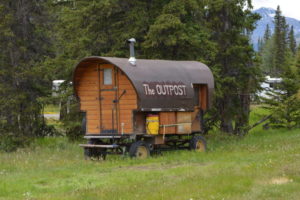 On the evening of our final night, the “site” next to us was taken up by a couple of men with tents who soon seated themselves on their picnic table and began tuning a fiddle and a banjo. Intrigued, my aunt befriended them and learned they were amateur musicians from Calgary who come to Bighorn Campground and play venue-appropriate music for the horse campers at night.
On the evening of our final night, the “site” next to us was taken up by a couple of men with tents who soon seated themselves on their picnic table and began tuning a fiddle and a banjo. Intrigued, my aunt befriended them and learned they were amateur musicians from Calgary who come to Bighorn Campground and play venue-appropriate music for the horse campers at night.
That evening they took up residence in the caretaker’s large tent and played music while everyone sang and perhaps even danced. I don’t know because we were so caught up in sky-gazing that we forgot to go ourselves.
The next night, after we left, my aunt and uncle took part in their second evening show, this one around a campfire. They said it was wonderful with additional musicians joining them. Three banjos! Giddy-the-hell-up, y’all! Wish we could have been part of that.
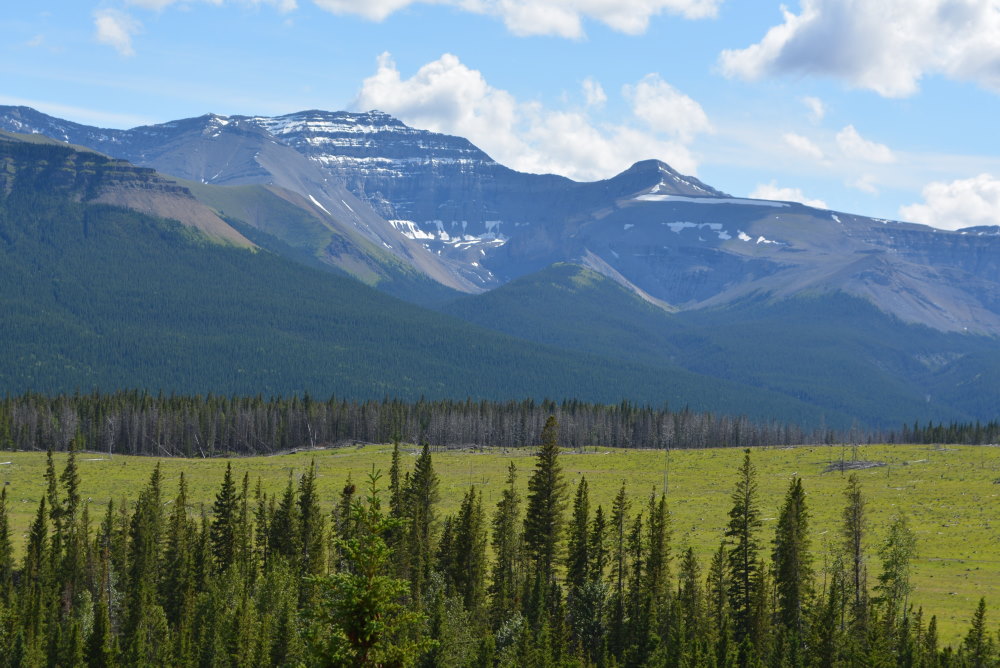
After such a unique and memorable outing, ranking Ya Ha Tinda and Bighorn Campground is rather difficult. This isn’t a stereotypical camping experience. On one hand, it’s an absolute 5 Baby Dill Pickles out of 5. Probably a 6 or 7 just for pure, extraordinary beauty and seclusion. Horse lovers and campers would no doubt agree. As would wannabe astronomers. And hikers. And, likely, mountain bikers. Oh, and fly fisherman. Oh, oh, and geocachers. Okay, pretty much anybody who loves nature will agree.
 On the other hand, if you’re looking for a family camping experience like you find at the bigger provincial parks on the big lakes in Alberta, or in the renowned mountain national parks like Banff and Jasper, then this is absolutely not for you. Just don’t bother. It isn’t what you want. And it isn’t fair rating it under such context.
On the other hand, if you’re looking for a family camping experience like you find at the bigger provincial parks on the big lakes in Alberta, or in the renowned mountain national parks like Banff and Jasper, then this is absolutely not for you. Just don’t bother. It isn’t what you want. And it isn’t fair rating it under such context.
Despite my conniption at nearly destroying our vehicles getting there, I unequivocally would go camping at Bighorn Campground in Ya Ha Tinda again. I may even rustle me a horse just to justify it, though I contend my telescope should be all the justification needed to come to this wondrous, rustic, mountain prairie.
*** Eagle Creek Campground is very close to Bighorn Campground and also offers equestrian facilities (open to regular campers as well) ***


Thank you for this thorough and fabulously-written review.
My pleasure.
I hope it was helpful.
Enjoy your visit.
Excellent review. We’re a group of hikers and will try it out July 1, 2 and 3. It is great to hear there is no cell service. Hopefully, everything is still the same! Best, Erik
Enjoy!